Texas Railroad History - Tower 69 - Celeste
A Crossing of the Gulf, Colorado & Santa Fe Railway and the
Missouri - Kansas - Texas Railway
 |
Left:
This photo of Tower 69 appears to have been taken early in its
existence, but the photographer and date are unknown. The tower sat at a
crossing of the Gulf, Colorado & Santa Fe (GC&SF, "Santa Fe") Railway
and the Missouri - Kansas - Texas (MKT, "Katy") Railway in Celeste, a
small community twelve miles northwest of Greenville. The tracks crossed
in an X-pattern with the tower in the obtuse angle east of the diamond.
The long side of the tower was parallel to the Santa Fe tracks which ran
on a 44-degree northeast heading while the Katy crossed on a 157-degree
southeast heading. The stairs were on the short side of the tower facing
the Katy (which are the tracks visible in the foreground.) The men are standing within the 67-degree angle north of the diamond
(barely visible at far
right) and they are obscuring a handcar on the Santa Fe tracks between
them and the tower. Later, a passenger station used by
both railroads was built west of the diamond, where the
camera sits for this photo facing
east-northeast.
 The
tower design
does not yield obvious clues as to who built
it, but it does not resemble typical
Santa
Fe towers. References in the
Celeste Courier newspaper to "Katy
Tower" suggest that it was staffed by Katy personnel and likely built by the Katy as well. The vertical arrangement of the
planks that comprise the exterior walls is rare. So far, only
Tower 58 (also a Katy/Santa Fe tower) has
been found to use a similar design. Most rectangular towers were made either
from wood boards horizontally attached or concrete
construction, at least the
first floor (and often by the Katy.) Tower
69 was built in 1907. The
tower design
does not yield obvious clues as to who built
it, but it does not resemble typical
Santa
Fe towers. References in the
Celeste Courier newspaper to "Katy
Tower" suggest that it was staffed by Katy personnel and likely built by the Katy as well. The vertical arrangement of the
planks that comprise the exterior walls is rare. So far, only
Tower 58 (also a Katy/Santa Fe tower) has
been found to use a similar design. Most rectangular towers were made either
from wood boards horizontally attached or concrete
construction, at least the
first floor (and often by the Katy.) Tower
69 was built in 1907.
Right:
This photo was taken
inside Tower 69. The back of the photo reads "Chief White, Celeste RR
Tower". On December 18, 1953, the Celeste
Courier reported "George Gaskins
succeeds Chief White at the Katy Tower as second trick operator."
[photos
provided by Celeste native Jerry Hunter, credited at his request to
The Mackie Don Baber Collection.] |
There are two reasons the Missouri - Kansas - Texas (MKT,
"Katy") Railroad did not build through Celeste
when tracks were laid from Denison to
Greenville in 1880. First, Celeste did not
exist at the time, nor was there any settlement at all where it eventually
sprang up, only open prairie. Second, it was not
the Katy doing the construction; it was a company with a similar name, the Missouri, Kansas
and Texas Extension Railway, which originally (1877) had been chartered as the Denison and
Southeastern Railway. In a blatant attempt to lure the Katy into buying the
railroad, its name was changed in the midst of construction after building into
Whitewright in March, 1880. Track laying continued
under the new name from Whitewright to Greenville, which was reached in
November, 1880, shortly after passing through the future site of Celeste. The Katy bought the railroad a year later.
The Gulf, Colorado & Santa Fe (GC&SF, "Santa Fe") Railway began building
northeast out of Dallas in 1886 with the eventual goal being
Paris near the Red River. In Farmersville, Santa Fe
crossed the narrow gauge East Line & Red River (EL&RR) Railroad which had built from
Greenville due west to McKinney in 1882, shortly after being acquired by the
Katy. Thirteen miles northeast of Farmersville, Santa Fe would need to cross the Katy's
Denison - Greenville line. Santa Fe's precise route had not been determined and
the only settlement along the Katy tracks in the vicinity of their preferred
route was Kingston, a town
founded in 1880 when the Katy had built through the area. Since railroad junctions
typically stimulated significant commerce, Santa Fe requested a bonus from
Kingston. The rationale was simple; if Santa Fe built through an established
town such as Kingston, the railroad's opportunity for revenue from lot sales was nil. If they
acquired undeveloped land elsewhere for the Katy crossing, they could profit
from founding a town and selling lots. When the citizens of Kingston refused to
pay the bonus, Santa Fe
bought land and built tracks across the Katy three miles northwest of Kingston.
There they established the town of Celeste, named for the wife of
a Santa Fe official. In less than ten years, Celeste and Kingston were the same size and
many Kingston businesses had relocated to Celeste. By 1914, Celeste was about
three times the size of Kingston. Celeste's population peaked at around a
thousand residents in the mid 1920s, but dwindled quickly during the Depression.
Most of the town of Celeste was located immediately west of the Santa Fe / Katy crossing, but
there was scattered housing on all sides. In 1924, future war hero and Hollywood
actor Audie Murphy was born near Kingston. He attended grade school in Celeste
and was living in Farmersville when he enlisted in the Army.
The April, 1948 issue of the
Katy employees' magazine had a story about the founding of Celeste due to
Kingston's refusal to pay Santa Fe a bonus. The article quoted a person, still
living in the area, who had been involved with making the decision 62 years earlier:
"There was some excitement about the matter
at the time," recalled Ira Murton England, eighty-six year old Tennessee
pioneer, who settled on a farm near Celeste in 1873. "Farmers around
Kingston held a mass meeting to talk over the problem. I was present at
the meeting myself. Tom Culver, who owned much of the land east of the
Katy tracks around Kingston, led the farmers in their action to refuse
the railroad. Culver was a success in his business. What he said was
good enough for the other farmers."
By 1896,
Kingston's fate had been decided.
"They
began selling real estate and other property in Kingston for less than
they paid for it," England said. "Most of the town's eight-hundred
persons just disappeared. Most of them came to Celeste, and a few went
to other places unaware that they were killing Kingston."
The GC&SF line
from Dallas to Paris was built as part of an agreement wherein the much larger
Atchison, Topeka & Santa Fe (AT&SF) Railway would acquire the GC&SF as a wholly
owned subsidiary when certain construction activities were complete. The
acquisition occurred in 1887 and the GC&SF continued operating as
a Texas-based railroad owned by the AT&SF. The line to Paris was
expected to be valuable because the St. Louis San Francisco ("Frisco") Railway
had a main line into Hugo, Indian Territory (Oklahoma) from Monett, Missouri via
Fort Smith, Arkansas and was
planning to bridge the Red River between Hugo and Paris. Paris was also on an
east/west line of the Texas & Pacific (T&P) Railway. The Red River bridge opened in 1888 and
the Frisco-chartered Paris & Great Northern Railroad built the 17 miles
between Paris and the bridge that same year.
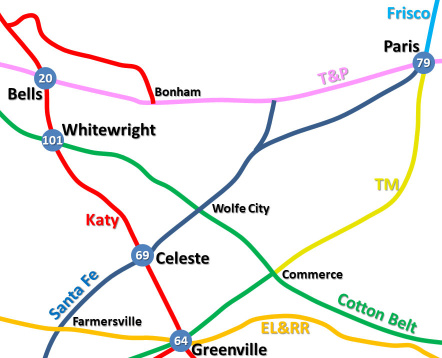 |
Left: This map
shows rail lines in the vicinity of Celeste with interlocking
towers identified by number. Roughly half of these lines have been
abandoned, and because they changed ownership over time, this map does
not represent any particular date. In addition to railroads already
mentioned, the St. Louis Southwestern ("Cotton Belt") Railway had tracks
in this area as did the Texas Midland (TM). Both the Cotton Belt and the
TM became owned by Southern Pacific (SP). The East Line & Red River
(EL&RR) did not exist by that name for very long, having been acquired
by the Katy shortly after it reached Greenville. Its track east of
Farmersville remains intact today, now owned by Kansas City Southern.
The unlabeled Santa Fe / T&P connection between Bonham and Paris was at
Honey Grove. Santa Fe's branch to Honey Grove split off at Ladonia. |
While traffic through Paris
was steady, it was nonetheless a "dead end" for the Santa Fe and thus dependent to some
extent on Frisco traffic over the bridge. In contrast, the Katy route north through
Denison led directly to Katy's extensive route structure in Oklahoma, Kansas and
Missouri. Frisco and Santa Fe did collaborate on
passenger service, operating the Texas Limited
between Dallas and St. Louis via Paris which passed through Celeste. Beginning
in 1915, Frisco and the Katy began jointly operating the Texas Special, a flagship
passenger service
for both railroads between San Antonio and St. Louis via the Red River bridge at
Denison. The Texas Special to Dallas passed through Celeste (there was
also Texas Special service to Ft. Worth that split off at Denison.) The
Katy also had passenger trains through Celeste that did not involve the Frisco.
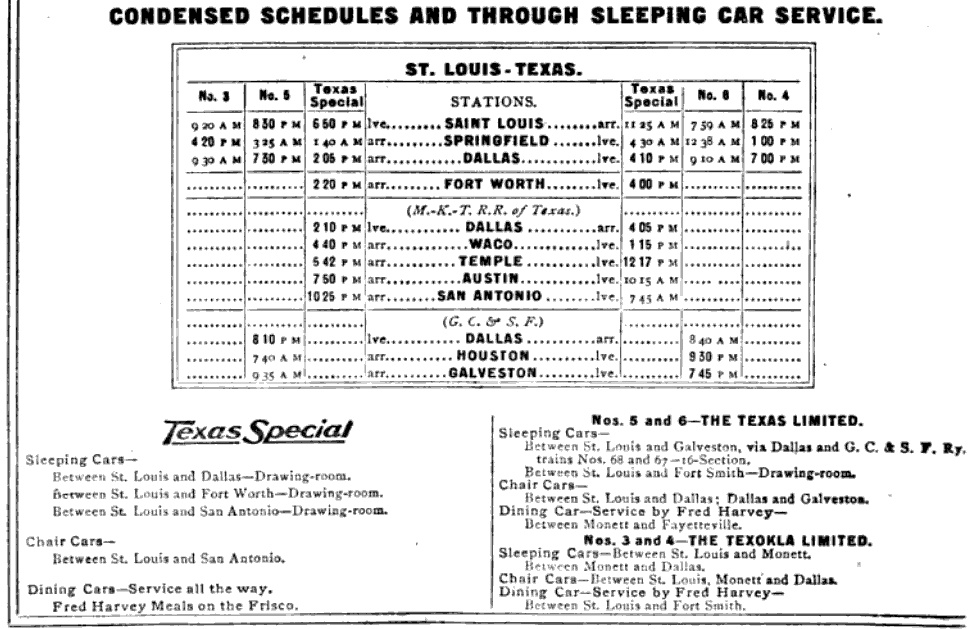
Above:
This ad for Frisco passenger service for the St. Louis - Texas market appeared in
the Official Railway Guide in 1923. The
Texas Limited
and the Texokla Limited passed through Celeste
on Santa Fe's tracks. The Dallas section of the
Texas Special
passed through Celeste on the Katy tracks.
There
was easily enough traffic over the diamond to justify a
manned interlocking tower at Celeste, and there turned out to be sufficient traffic to sustain that need for
nearly 50 years. On March 30, 1907, the Railroad Commission of Texas (RCT) authorized Tower 69 to begin operations at Celeste
to manage the Katy / Santa Fe crossing. The tower housed a mechanical interlocking plant
with 32 functions, a relatively high number, likely due to signals and switches controlled from the tower for station tracks, exchange tracks and sidings.
The contract between the two railroads for the operation and maintenance of Tower 69
was dated July 22, 1907. For an "indefinite" duration, the railroads
agreed to split all tower-related expenses
evenly.
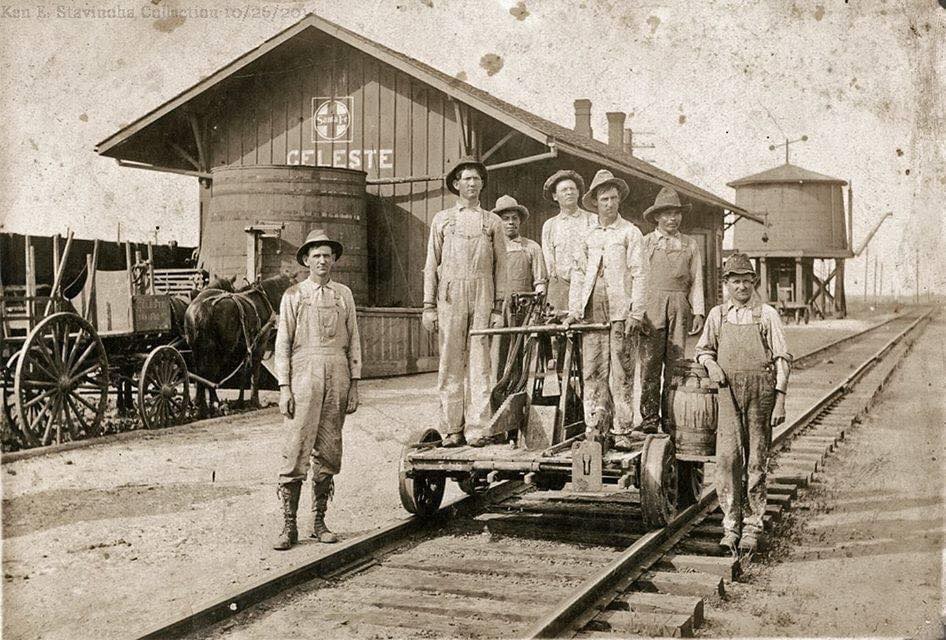 |
Left: Celeste Santa Fe depot,
c.1913, Ken Stavinoha Collection
Below:
In the 1920s, a Union Passenger Station was built west of the
diamond. The south wing faced the Santa Fe tracks and housed the
passenger waiting room. The north wing faced the Katy tracks and housed
the baggage area and the Railway Express office. In this aerial image, Tower 69 is obscured by
the copyright text, but its shadow
is visible northeast of the crossing. (1956 image
(c)historicaerials.com)
 |
 |
Left: This
1915 track chart of Celeste (courtesy Ed Chambers) shows the track
arrangement prior to the construction of the Union Passenger Station.
The inset photo c.1930 shows the union depot and the tower. The construction of the joint station in the
1920s gave the town the type of facility that larger towns enjoyed.
There was limited need to change trains conveniently (a major benefit of
joint stations) in Celeste, but it did occur, as noted below.
Below: Perhaps when the joint passenger station was
being planned, the oldtimers in Celeste recalled this story in
Railway Age from December, 1896.

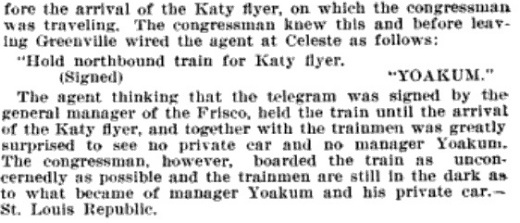 |
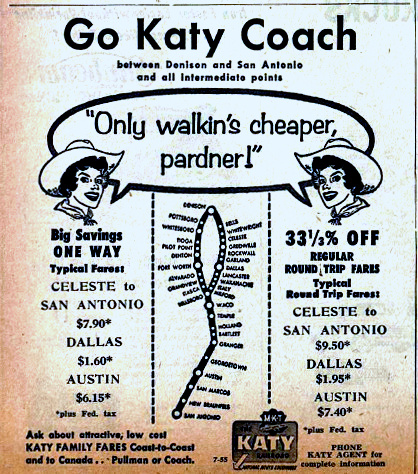 |
Left: This Katy advertisement
appeared in the Celeste Courier,
April 29, 1955. In November of that year, Santa Fe initiated legal steps to
terminate its daily passenger service between Dallas and Paris which
stopped at Celeste.
Below and Right:
The Celeste Courier of January 20, 1961
lamented the recent razing of the railroad station and described the
trains that still passed through Celeste.
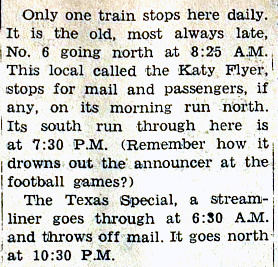 |
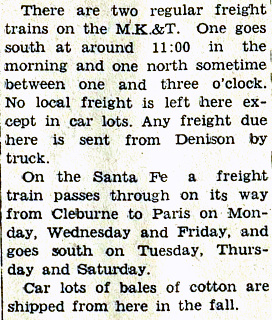
With such
limited traffic, it is no surprise that at the time this article was
written in January, 1961, Tower 69 had
been razed more than four years earlier. |
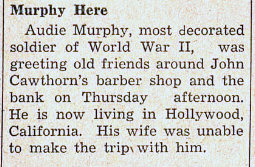
Above: Like Kingston
and Farmersville, Celeste claimed to be the home of Audie Murphy. His
visit to Celeste was noted in the Courier
on October 19, 1951.
Below:
This ad for an Audie Murphy movie at the theater in Leonard appeared in
the Courier,
June 15, 1956.
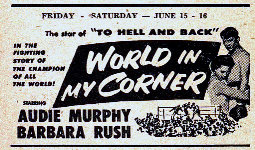 |
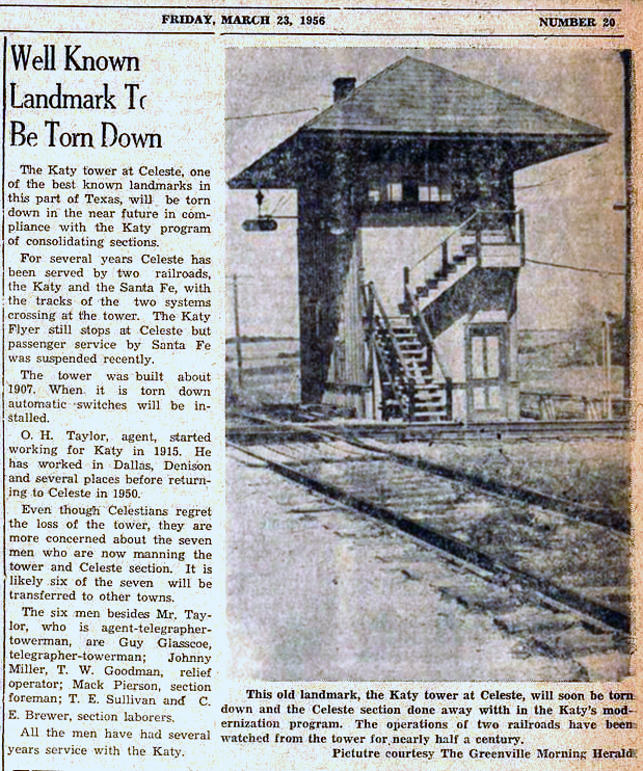 |
Left: This front page story in the
Celeste Courier of March 23, 1956
announced the future demise of Tower 69
Below: The
Courier of September 19,
1952 noted an incident that injured telegraph operator Glasscoe (whose
name appears in all three articles.)
Right: Before removing
the tower, an automatic interlocker needed to be installed as a
replacement. The installation was announced in the August 31, 1956 issue of the
Courier.
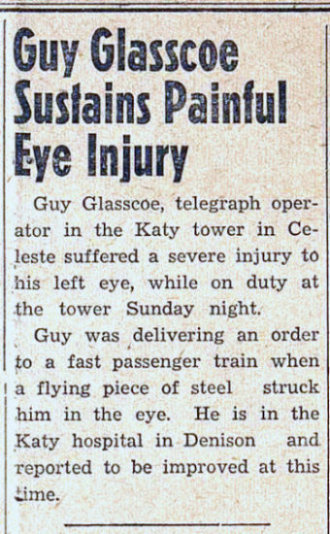 |
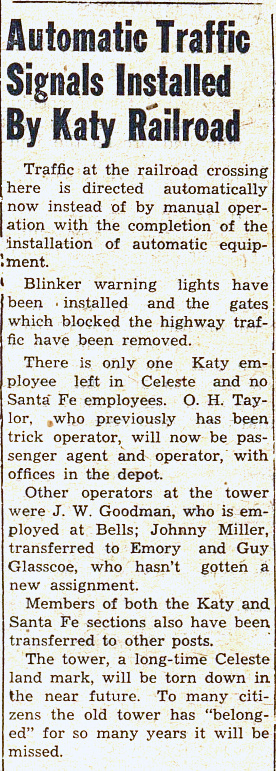 |
The Santa Fe line between Paris and Farmersville was
sold in 1990 to Chaparral Railroad, an affiliate of the Kiamichi Railroad
which operated the former Frisco lines through Hugo, Oklahoma and the line from
the bridge to Paris. When Chaparral abandoned the line in 1995, a coalition of organizations came together to acquire the
right-of-way (plus additional right-of-way on the
abandoned T&P rail line between Paris and New Boston) under the rail-banking process of the National
Trails Act. These rights-of-way have since been developed into the
Northeast Texas Trail. The ex-Katy
line through Celeste remains in use, now owned by Genesee & Wyoming and operated
by its Dallas, Garland and Northeastern (DG&NO) Railroad subsidiary. At
Bells, the track merges with the
former T&P line and proceeds into Sherman. East of
Bells, the former T&P tracks remain intact to Bonham but are mostly used for car
storage.
The Katy tracks between Bells and Denison were removed in 1988.


Above Left: Looking northwest in 2005 on the former Katy
line, a walk-in equipment cabin sits trackside near the former Tower 69
crossing. It is very likely the same cabin that housed the automatic interlocker that
replaced Tower 69. It no longer served that purpose; by 2005, the Santa Fe
tracks had been gone for a decade. Yet, the relatively new door and the power
line connection suggest that the cabin may have still housed equipment,
perhaps for nearby signals or grade crossing controls. (Myron Malone photo) Above Right: The
remnant of the foundation of Tower 69 is located across the Santa Fe
right-of-way from the automatic interlocker cabin. (Myron Malone photo 2005)

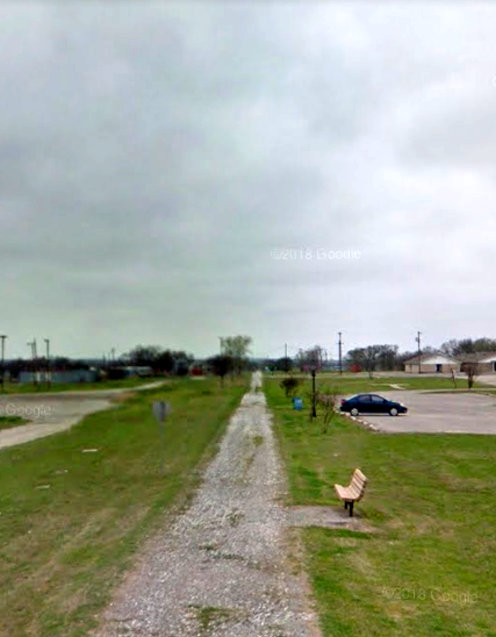
Above Left:
The former Katy line, now operated by DG&NO, is visible running top to bottom
on a slight diagonal in
this bird's eye view of the Tower 69 crossing c.2008. The abandoned Santa Fe
line is visible as a paved trail crossing diagonally left to right. The
automatic interlocker cabin still sits among the trees on the north side of the
former diamond. A DG&NO equipment cabin sits in the
middle of the triangle formed by the Katy
and Santa Fe rights-of-way and US Highway 69.
Above Right: looking south from US 69 along the Santa Fe
right-of-way, now the Northeast Texas Trail (Google Street View, March, 2018)
Below Left: This view shows the new equipment cabin with red and
white indicators on top. In the distance, a rail crew is working on the track.
Note that the power line to the automatic interlocker cabin seen in the 2005 photo
has been removed. (Google Street View,
March, 2018) Below Right: This
is the north view along the former Santa Fe right-of-way, now the Northeast
Texas Trail. (Google Street View, March, 2018)
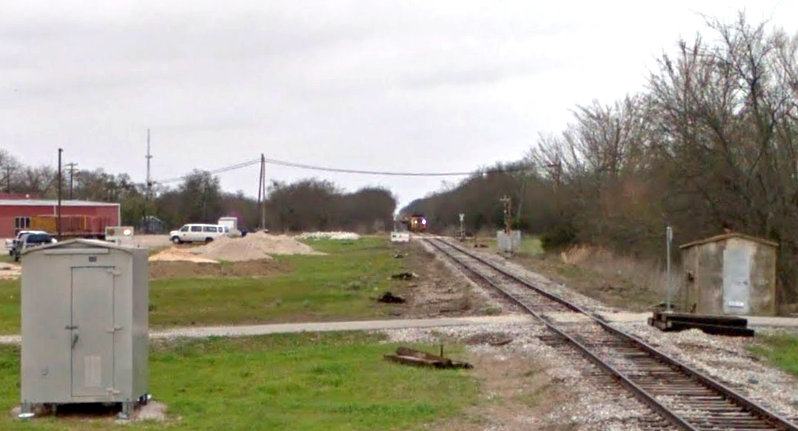
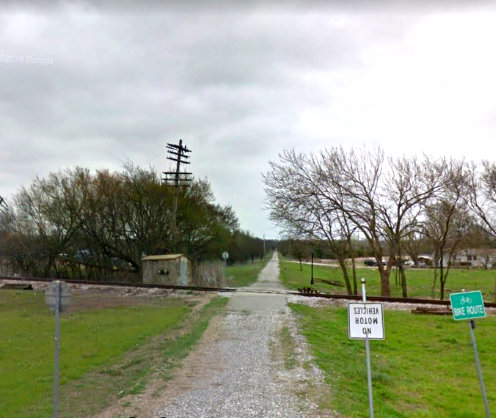

 The
tower design
does not yield obvious clues as to who built
it, but it does not resemble typical
Santa
Fe towers. References in the
Celeste Courier newspaper to "Katy
Tower" suggest that it was staffed by Katy personnel and likely built by the Katy as well. The vertical arrangement of the
planks that comprise the exterior walls is rare. So far, only
Tower 58 (also a Katy/Santa Fe tower) has
been found to use a similar design. Most rectangular towers were made either
from wood boards horizontally attached or concrete
construction, at least the
first floor (and often by the Katy.) Tower
69 was built in 1907.
The
tower design
does not yield obvious clues as to who built
it, but it does not resemble typical
Santa
Fe towers. References in the
Celeste Courier newspaper to "Katy
Tower" suggest that it was staffed by Katy personnel and likely built by the Katy as well. The vertical arrangement of the
planks that comprise the exterior walls is rare. So far, only
Tower 58 (also a Katy/Santa Fe tower) has
been found to use a similar design. Most rectangular towers were made either
from wood boards horizontally attached or concrete
construction, at least the
first floor (and often by the Katy.) Tower
69 was built in 1907.



















